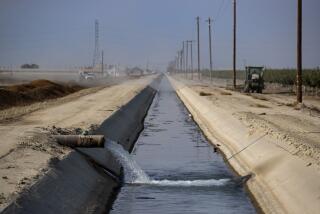An Encouraging Report From the Water Front
- Share via
Despite a growing population and increasing electricity production, America’s use of water is lower than it was 30 years ago, a sign that “conservation is working,” according to a national report issued Wednesday by the U.S. Geological Survey.
The report, which is issued every five years, says that Americans in 2000 used 408 billion gallons of water a day -- virtually unchanged since 1985 and lower than in 1975.
USGS chief hydrologist Robert Hirsch said conservation and advances in irrigation techniques and power generation “allow us to do more with less water.... It’s pretty good news for the nation.”
Nationwide, per-capita use of water has dropped 25% from its peak in the 1970s.
The report is intended to help public agencies and private industry plan for water needs. Among other uses, the information is considered in decisions involving the withdrawal of water from rivers, lakes, estuaries and groundwater supplies.
Adan Ortega, vice president of the Metropolitan Water District of Southern California -- wholesalers to 18 million residents in six counties -- said the report confirmed the district’s view that its programs to encourage conservation and recycling were taking hold.
The MWD has distributed 2 million low-flush toilets and is hip-deep in a program to encourage backyard gardeners to save water by, among other things, using native plants. In a decade, per-capita water use in Southern California has dropped nearly 20%, from 210 gallons per day to 170 gallons.
“It’s good news, but it shouldn’t be taken as a signal to Southern Californians that they don’t need to do more,” Ortega said of the USGS findings. “We still need to do more.”
Peter Gleick, president of the Oakland-based Pacific Institute, an environmental research group, said the report indicated the death of conventional wisdom in the water industry.
“This shows that one of the key assumptions of U.S. water planners is wrong: We don’t have to build massive new water projects to meet ever-increasing demand,” he said.
That view is not universally held.
Ortega, for example, said the MWD believed in a “no-regrets” approach encompassing conservation and increased storage to prepare for unpredictable changes -- such as climate shifts and population growth.
Although public perception, thanks to the widespread brick-in-the-toilet conservation program, centers on water use by households, the bulk of the nation’s water consumption remains in the generation of electricity (48%) and in irrigation (34%).
Homes and businesses account for 11% of the nation’s water usage.
Other users -- including livestock, mining and domestic wells -- account for 7%.
One dark cloud in the USGS report is a finding of an increasing reliance on aquifers. In 1950, 23% of America’s irrigation water came from aquifers; in 2000, the figure was 43%.
“In too many places our underground aquifers are already overstressed,” Gleick said.
Overdrafting of aquifers has been an issue in Orange County and the Coachella Valley, among other places. The MWD has launched a plan to replenish aquifers in the Central Valley, Ventura, the Chino Basin and east of Palm Springs.
Nationwide, the percentage of the water supply used for crop irrigation has remained relatively unchanged for more than half a century. But the amount of acreage more than doubled from 1950 to 1980, then jumped an additional 7% between 1995 and 2000.
In many areas, farmers have aggressively sought innovative irrigation methods. But elsewhere, farm efficiency been a matter of survival.
“In other areas,” the report says, “increased costs and reduced water availability have led to more efficient irrigation practices and a reduction in irrigation water use.”
More to Read
Sign up for Essential California
The most important California stories and recommendations in your inbox every morning.
You may occasionally receive promotional content from the Los Angeles Times.










